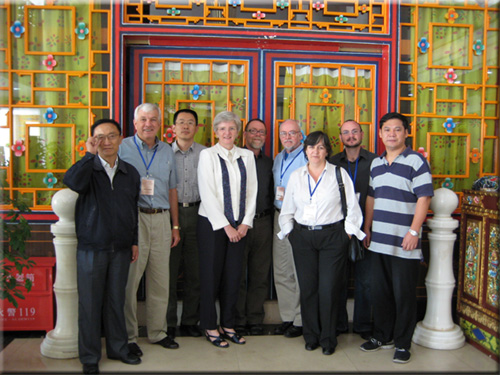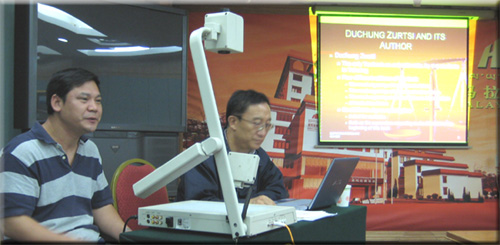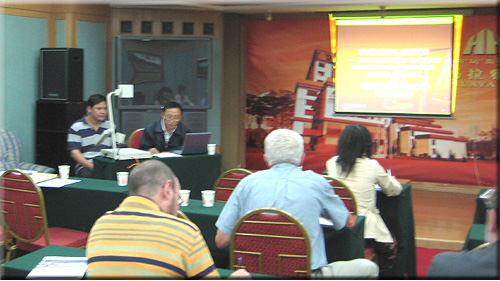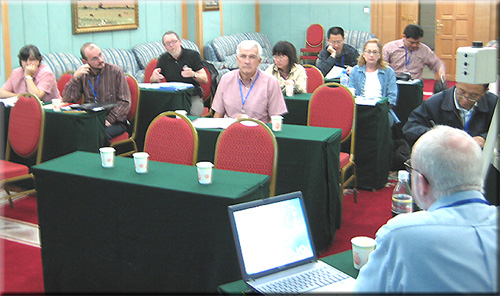Report on the ICHM-Sponsored Satellite Session on the History of Mathematics of the Fourth International Congress on Representation Theory (ICRT IV) Held in Lhasa, Tibet
Thursday and Friday, 19-20 July, 2007
by Karen V. H. Parshall
This session of nine, forty-five-minute talks was co-organized by Joseph W. Dauben (City University of New York), XU Yibao (Borough of Manhattan Community College), and Karen V. H. Parshall (University of Virginia) in conjunction with Da Luosang Langjie (Tibet University) and WANG Jian-pan (East China Normal University). Wang was the principal organizer of ICRT IV and originally suggested the possibility of an associated satellite session in the history of mathematics.

Speakers, Titles, and Abstracts (in alphabetical order by speaker)
Chinese Mathematicians and the International Research Community: The Case of HU Mingfu and Integral Equations
Tom Archibald, Department of Mathematics, Simon Fraser University, Burnaby, BC V5A 1S6, Canada
tarchi@sfu.ca
The late nineteenth century saw a revival of interest in European mathematics in Chinese educational circles. The overall background to this development has been described by Dauben; Dauben and Zhang give additional information on the question of exchanges between the US and China in the early twentieth century. In this talk, I discuss the early career of Hu Mingfu (1891-1927), who studied at Cornell supported by the Boxer Indemnity. Hu went on to be the first Chinese national to complete a Ph. D., which he did at Harvard in 1917 in mathematics. His thesis, supervised by M. Bôcher, was on integral equations, a subject that was enjoying explosive growth at that time. If time permits, I will compare Hu's career to that of some other early Chinese students abroad.
Commercial Arithmetic in the Spanish Renaissance
Elena Ausejo, Facultad De Cierrcias (Mathematicas), University of Zaragoza, E-50009 Zaragoza, Spain
ichs@unizar.es
Juan de Yciar (1522-1590), the most important calligrapher in the Spanish Renaissance, is also the author of works such as Libro Subtilissimo, por el qual se enseña a escreuir y contar perfectamente el qual lleua el mesmo orden que lleua vn maestro con su discipulo Hecho y experimentado por Iuan de Yciar Vizcayno (Book That Teaches How To Write and Count in the Same Order as a Teacher Does with His Student;Made and Tested by Iuan de Yciar Vizcayno), and Arte Breue y Prouechoso de cuenta Castellana y Arithmetica, donde se muestran las cinco reglas de guarismo por la cuenta castellana, y reglas de memoria. Y agora nueuame[n]te en esta postrera impression se han añadido vnas cuentas muy graciosas y prouechosas, sacadas del libro de Fray Iuan de Ortega : y mas al cabo va añadida vna cuenta abreuiada de marauedis (Brief and Useful Art of Castilian Counting and Arithmetic, Where the Five Rules of Figure on Castilian Reckoning Are Shown, and Memory Rules. And Now in This Last Edition Very Amusing and Useful Calculations, from Fray Iuan de Ortega's Book, Have Been Added, and at the End an Abridged Count of Maraveds). Both of these works, which had been printed in Zaragoza by the mid sixteenth century, testify to Juan de Yciar's interest in teaching counting together with writing. One of his rarer books entitled Libro intitulado aritmética práctica muy provechoso para toda persona que quisiere ejercitarse en aprender a contar (Book Entitled Practical Arithmetic Very Useful for Everybody Willing To Be Trained in Reckoning Learning) (1549) is purely mathematical. Until recently, only a single copy of the latter work had been thought to survive and that in the British Library. This talk will examine the contents of a second copy of the book that has recently been found in Spain.
The Chou Suan by Giacomo Rho: An Example of Mathematical Adaptation in China
Jose A. Cervera, ITESM, Campus Monterrey, Dep. Estudios Humanisticos, 64849 Monterrey, Mexico
j.a.cervera@itesm.mx
The Jesuits Giacomo Rho (Luo Yagu, 1592-1638) and Adam Schall von Bell (Tang Ruowang, 1592-1666) translated a huge number of European astronomical and mathematical treatises into Chinese between 1630 and 1635. The result (137 juan) was given the name Chongzhen Lishu (Calendar Compendium of the Chongzhen Era). It was reedited in 1645 with the new name Xiyang Xinfa Lishu (Calendar Compendium According to the Western New Methods). One of the mathematical treatises included in the Xiyang Xinfa Lishu was the Chou Suan (Calculus with Rods), written by Rho in 1628. The Chou Suan is the adaptation of John Napier's Rabdology (1617). There are several differences between the Rabdology and the Chou Suan. The latter gives more details on every use of the rods. Most important, the examples in the Chou Suan are practical ones. In this way, Rho shows his inculturation, following the patterns of traditional Chinese books on mathematics. In this talk, I will give a general survey on Giacomo Rho¡¯s Chou Suan, and I will compare this book with Napier¡¯s Rabdology as a typical example of adaptation of European mathematics in China.
Zhu Shijie and the Jade Mirror of the Four Unknowns
Joseph W. Dauben, Herbert H. Lehman College and Ph. D. Program in History, The City University of New York, 504 West 110th St., FC, New York, NY 10025, USA
jdauben@gc.cuny.edu; jdauben@att.net
The Yuan dynasty mathematician Zhu Shijie published his Jade Mirror of the Four Unknowns (also known as The Precious Mirror of the Four Elements) in Yangzhou in 1303. Widely regarded as the most significant work of traditional Chinese mathematics, the Jade Mirror offers a systematic method for solving simultaneous equations in as many as four unknowns. This work has been translated into French with a comprehensive commentary in the doctoral thesis of Jock Hoe (1977). Recently, an English translation made by Ch'en Tsai Hsin (1879-1945) in 1925 found in the library of the Institute for the History of Natural Science in Beijing has been edited and published by Guo Shuchun and Guo Jinhai (2006). This talk will discuss the meaning of the title of the treatise by Zhu Shijie, and explain the significance of the generalization of the "celestial element" method that he used to provide a very powerful, general method for the solution of simultaneous equations in the context of traditional Chinese mathematics.
Antoine Thomas (1644-1709) and the First Introduction of Western Algebra into China
Qi Han, Institute for the History of Natural Science, Chinese Academy of Sciences, Beijing 100010, China
hanqi@ihns.ac.cn
Antoine Thomas (1644-1709), a Belgian Jesuit from Namur, was a very important figure in the history of science in the seventeenth and eighteenth centuries. After he arrived in Beijing in 1685, he soon served as vice-president of the Imperial Board of Astronomy and as an assistant of his confrère, the Belgian Jesuit F. Verbiest (1623-1688). After 1688, he served as an imperial tutor of science of the Kangxi Emperor along with T. Pereira (1645-1708) and the French Jesuits J. Bouvet (1656-1709) and J.-F. Gerbillon (1654-1707). The most important of his scientific work in China was his meridian-line work in 1702. Through astronomical observations, he established the relation between the li and the degree of terrestrial latitude. Research on Antoine Thomas's scientific activities has only used European sources. In this talk, I would like to analyze his scientific activities on the basis of both Chinese and European sources and to identify him as the author of a book on algebra Jiegenfang Suanfa (Aspects of the Mathematical Method of Jiegenfang) and its abridged edition Jiegenfang Suanfa Jieyao (Essential Aspects of the Mathematical Method of Jiegenfang). I would also like to analyse Jiegenfang Bili, which was based on the former, and show its influence on Qing mathematicians in the eighteenth and nineteenth centuries.
Duchung Zursti: A Secular and Official Tibetan Mathematical Textbook
Da Luosang Langjie, Tibet University, Lhasa, Tibet 850000, China
lslj@x263.net
Duchung Zurtsi is a mathematical textbook written by Duchungpa A-nanda, a great scholar and a controller in the 5th Dalai Lama Ngagwang Lolsag Gyatso period (1617-1682). The book is the earliest extant mathematical textbook in Tibetan. It mainly deals with rod-arithmetic in conversions between different volume measuring tools, which involve complicated operations of fractions. This book provides invaluable material for studying the development of mathematics and of mathematics education in Tibet. This talk will explore the contents and main features of the book as well as the important methods contained therein. It will also analyze the impact of the book on the Tibetan economy in the seventeenth century and thereafter and raise several issues for further study. This is joint work with Xuanji Hua (Fudan University, Shanghai, China).


4000 Years of Algebra: An Historical Tour from BM 13901 to Moderne Algebra
Karen Hunger Parshall, Departments of History and Mathematics, University of Virginia, Charlottesville, VA 22904-4137, USA
khp3k@virginia.edu
How is it that the high school analysis of polynomial equations and the modern algebra of the research mathematician—so seemingly different in their objectives, in their tools, and in their philosophical outlook—are both called algebra ? Are they even related? The fact is that they are. This talk will sketch the long and complicated story of how they are related via a 4000-year-long history that stretches from Mesopotamia around 1800 B.C.E.—when mathematicians recorded an algorithm for solving quadratic equations on clay tablets like BM 13901, held today in the British Museum—to the publication in 1930 of Bartel van der Waerden's classic text, Moderne Algebra.
Chinese Gougu Theory Versus Euclidean Geometry: Views of a Seventeenth-Century Chinese Mathematician
Yibao Xu, Borough of Manhattan Community College, The City University of New York, New York, NY 10007, USA
yxu@bmcc.cuny.edu
Mathematics in China now, as this Fourth International Conference for Representation Theory indicates, has become an active part of world mathematics. About 100 years ago Chinese mathematics, however, remained distant from the mainstream of Western mathematics. The differential and integral calculus, algebra, and probability theory were only introduced to China in the second half of the nineteenth century, and the question of how traditional Chinese mathematics interacted with Western mathematics is a subject that remains to be explored in detail. This year, however, marks the four hundredth anniversary of the publication of the Chinese translation of the first six books of Euclid's Elements by Matteo Ricci, known as Li Madou in China, and Xu Guangqi. This talk will discuss the first actual interaction between Western and Chinese mathematics in the work of the great Chinese mathematician Mei Wending (1633-1721). How he merged traditional Chinese gougu theory with the newly-introduced Greek geometry will be examined in the context of a manuscript copy of the Chinese translation of the Elements preserved in the David E. Smith Archives in Columbia University's Rare Books and Manuscripts Library. Whether this manuscript is the one actually used by Mei himself, and if so, how the marginal annotations in the manuscript may be related to his published works, will also be considered.
Miss Mullikin and the Internationalization of Topology
David E. Zitarelli, Department of Mathematics, Temple University, Philadelphia, PA 19122, USA
zit@temple.edu
The necessity for a formal definition of a connected set arose at the beginning of the nineteenth century, when three mathematicians—one each from the United States, Hungary, and Germany—arrived at the same expression. However, it was another pair in a fourth country, Poland, who in 1921 presented the first investigation devoted entirely to connected sets. At the same time, Anna Mullikin (1893-1975) was conducting a research program on such sets entirely unaware of the others. In this talk, I introduce this high-school teacher and present her work in the context of the development of topology in the 1920s. I also describe how one of her theorems helped catalyze an era of international cooperation and competition between schools of topology in Poland and the U.S. As an added bonus, I will demonstrate how Mullikin's nautilus can be used to illustrate limits geometrically in the plane to a class in advanced calculus.
